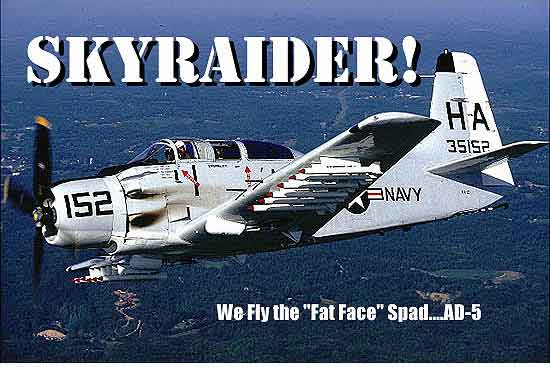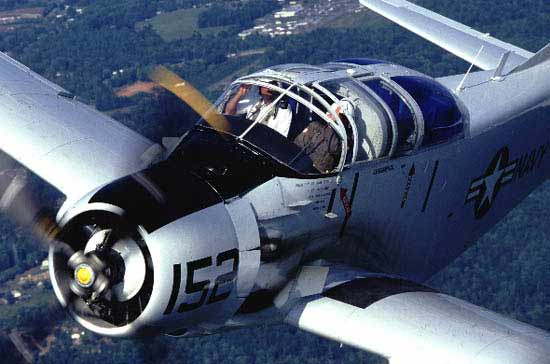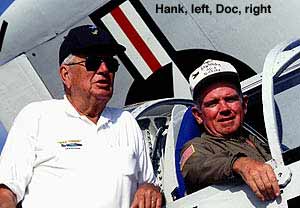 |
AD-5 Skyraider: Dipping
into the Horsepower Pool |
PAGE THREE The AD-5 like Hank Avery's was a deliberate attempt to take what was already a tremendously useful airplane to far higher levels of utility. In fact, the AD-5 and its variants have been pointed out as one of the most utilitarian combat airplanes ever built.

The fuselage was completely redesigned from the single-seat versions to give the flight deck far more room than necessary for two pilots. Then a wide compartment was build behind it which could be configured in different ways for different missions. It could carry as many as ten passengers or a staggering load of electronic gear to carry out Electronic Counter Measures missions, act as a specialized AWACs, FAC's or, as was often the case, carry anything they could stuff in it. Hank's airplane at one time had carried a goiter-like radome under its nose. The widebody Spads were sometimes referred to as "fat-face's" by their pilots. Regardless of the load or mission contained within the fuselage, however, the AD-5 was still a Skyraider. It was still a gun toting, bomb dropping ground pounder. When I first strapped into Hank's Skyraider I was struck by a number of unusual impressions all at the same time. As I dropped into the seat, I couldn't believe the visibility. Most WWII vintage airplanes, Stearman to Mustang, share at least one common characteristic. You can't see squat over the nose. During takeoff and landing, your world is defined by the sides of the runway visible around the nose. Not so in the Skyraider. Here the nose is a sizable amount below your line of vision. You're sitting so high that, despite the huge cockpit, it is as if you're sitting "on" the airplane, not "in" it. The cockpit is much wider than most twin engine airplanes. In fact, it's possible a yardstick would find it nearly as wide as a B-25, but the bubble type canopy imparts an almost "airy" feeling to it. The control stick is just a little unusual, if nothing else because it pivots for pitch at the bottom but pivots for roll about half way up. This is exactly the same as a Spitfire and you don't even notice it once the engine is running. The rest of the cockpit is strangely simple compared to it's WWII counter parts thanks to automatic servos in some of its systems. With the cost of an overhaul on an R-3350 approaching that of a small North Carolina house, starting the engine isn't a casual affair. Every effort is made to avoid hydraulic locks due to oil in the cylinders or bearing damage due to the oil running down off bearing surfaces while the airplane is inactive .
Hit pre-oiler to force oil into bearings before turning the engine over. Yell "clear." Engage starter, count eight blades. Stop cranking. Hit pre-oiler again. While this is happening high pressure oil is making certain all the engine bearings are liberally bathed in oil. Engage starter and count sixteen blades, four revolutions, to clear cylinder of oil. The bottom cylinders of a radial, especially Wrights, love to collect oil, while sitting. Fire it up with oil in a cylinder and the compression ratio goes to a billion to one and a rod is bent. It's a very expensive noise. Now the engine is oiled, cleared and ready to start. Aux Hydraulic boost is checked, to make sure it's working in case the primary system isn't. Fuel boost on, crank another eight blades. Primer button down. Keep cranking. Reach up with a free hand and flick the mag switches to "both." At this point a series of hollow coughs belch intermittent clouds of blue smoke past us. The smell of a radial engine permeates the cockpit. Eau de Roundmotor. Nothing smells like it. In seconds the coughs blend together. The primer button is held down until it's running and the mixture control next to the throttle is shoved forward to rich. Check oil pressure. Hydraulic pressure Everything else coming up. A living breathing horsepower factory is now sitting just in front of our feet. I leave my side of the canopy open and breath in a little wonderfully
fragrant toxic waste. |
 Area clear. Master on. Mags off. Mixture auto
cut-off.
Area clear. Master on. Mags off. Mixture auto
cut-off.